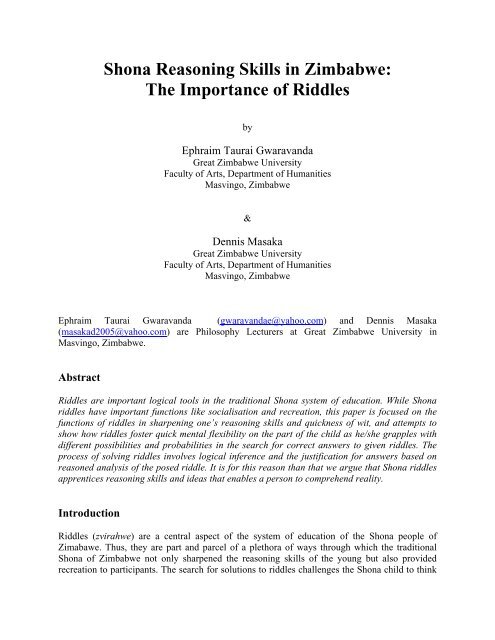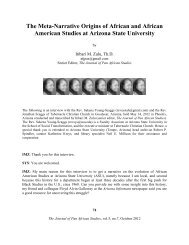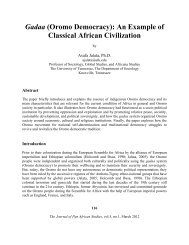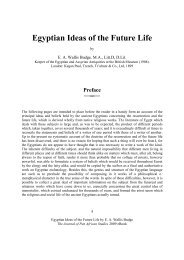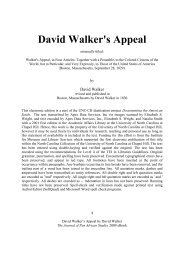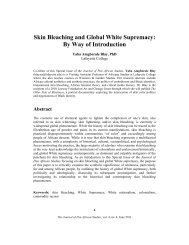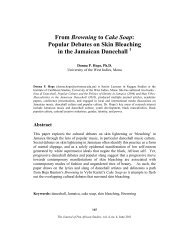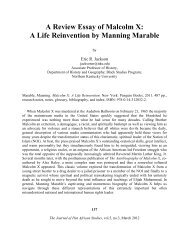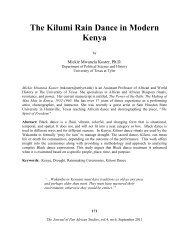Shona Reasoning Skills in Zimbabwe: The Importance of Riddles
Shona Reasoning Skills in Zimbabwe: The Importance of Riddles
Shona Reasoning Skills in Zimbabwe: The Importance of Riddles
Create successful ePaper yourself
Turn your PDF publications into a flip-book with our unique Google optimized e-Paper software.
<strong>Shona</strong> <strong>Reason<strong>in</strong>g</strong> <strong>Skills</strong> <strong>in</strong> <strong>Zimbabwe</strong>:<br />
<strong>The</strong> <strong>Importance</strong> <strong>of</strong> <strong>Riddles</strong><br />
by<br />
Ephraim Taurai Gwaravanda<br />
Great <strong>Zimbabwe</strong> University<br />
Faculty <strong>of</strong> Arts, Department <strong>of</strong> Humanities<br />
Masv<strong>in</strong>go, <strong>Zimbabwe</strong><br />
&<br />
Dennis Masaka<br />
Great <strong>Zimbabwe</strong> University<br />
Faculty <strong>of</strong> Arts, Department <strong>of</strong> Humanities<br />
Masv<strong>in</strong>go, <strong>Zimbabwe</strong><br />
Ephraim Taurai Gwaravanda (gwaravandae@yahoo.com) and Dennis Masaka<br />
(masakad2005@yahoo.com) are Philosophy Lecturers at Great <strong>Zimbabwe</strong> University <strong>in</strong><br />
Masv<strong>in</strong>go, <strong>Zimbabwe</strong>.<br />
Abstract<br />
<strong>Riddles</strong> are important logical tools <strong>in</strong> the traditional <strong>Shona</strong> system <strong>of</strong> education. While <strong>Shona</strong><br />
riddles have important functions like socialisation and recreation, this paper is focused on the<br />
functions <strong>of</strong> riddles <strong>in</strong> sharpen<strong>in</strong>g one’s reason<strong>in</strong>g skills and quickness <strong>of</strong> wit, and attempts to<br />
show how riddles foster quick mental flexibility on the part <strong>of</strong> the child as he/she grapples with<br />
different possibilities and probabilities <strong>in</strong> the search for correct answers to given riddles. <strong>The</strong><br />
process <strong>of</strong> solv<strong>in</strong>g riddles <strong>in</strong>volves logical <strong>in</strong>ference and the justification for answers based on<br />
reasoned analysis <strong>of</strong> the posed riddle. It is for this reason than that we argue that <strong>Shona</strong> riddles<br />
apprentices reason<strong>in</strong>g skills and ideas that enables a person to comprehend reality.<br />
Introduction<br />
<strong>Riddles</strong> (zvirahwe) are a central aspect <strong>of</strong> the system <strong>of</strong> education <strong>of</strong> the <strong>Shona</strong> people <strong>of</strong><br />
Zimabawe. Thus, they are part and parcel <strong>of</strong> a plethora <strong>of</strong> ways through which the traditional<br />
<strong>Shona</strong> <strong>of</strong> <strong>Zimbabwe</strong> not only sharpened the reason<strong>in</strong>g skills <strong>of</strong> the young but also provided<br />
recreation to participants. <strong>The</strong> search for solutions to riddles challenges the <strong>Shona</strong> child to th<strong>in</strong>k
abstractly, broadly and deeply while their figurative language gives the child the chance to<br />
uncover their mean<strong>in</strong>g through a reason<strong>in</strong>g process. <strong>The</strong> answer to a given riddle acts as a<br />
conclusion <strong>of</strong> the logical process and it is <strong>of</strong>ten a one word answer which both precise and clear<br />
to the participants. In <strong>Shona</strong> society, riddles promote logical skills and the one who is capable <strong>of</strong><br />
solv<strong>in</strong>g many riddles is arguably more mentally sophisticated than the one who is less capable.<br />
That riddles are a permanent feature <strong>of</strong> the <strong>Shona</strong> way <strong>of</strong> life, therefore, uncontested, this<br />
prompted Gelfand (1973:5) to commend that “the <strong>Shona</strong> possess much that is worth reta<strong>in</strong><strong>in</strong>g<br />
and the prospects are that they will save a good deal <strong>of</strong> it for succeed<strong>in</strong>g generations.” Though<br />
the tide <strong>of</strong> Western colonisation and globalisation has swept across the <strong>Shona</strong> territory, great<br />
many aspects <strong>of</strong> their way <strong>of</strong> life have been reta<strong>in</strong>ed and this <strong>in</strong>cludes riddles.<br />
<strong>The</strong> ideal time for pos<strong>in</strong>g riddles among the <strong>Shona</strong> is dur<strong>in</strong>g the even<strong>in</strong>g around a glow<strong>in</strong>g fire,<br />
usually led by an elder when all family members have f<strong>in</strong>ished their various chores and are<br />
prepar<strong>in</strong>g to go to bed. Pos<strong>in</strong>g riddles any other time <strong>of</strong> the day would be considered a nuisance<br />
distraction <strong>of</strong> other important human assignments. For this reason, scholarship takes them as,<br />
primarily as a form <strong>of</strong> recreation rather than a method <strong>of</strong> <strong>in</strong>struct<strong>in</strong>g the young about important<br />
truths about life. However, this paper argues that the core <strong>of</strong> <strong>Shona</strong> riddles is their <strong>in</strong>structive<br />
aspect <strong>in</strong> so far as they endeavour to sharpen the reason<strong>in</strong>g skills <strong>of</strong> their apprentices. It,<br />
therefore, argues that <strong>Shona</strong> riddles’ primary objective is not recreational but <strong>in</strong>structional.<br />
Justify<strong>in</strong>g Rationality<br />
<strong>The</strong> term <strong>Shona</strong> refers to various l<strong>in</strong>guistic dialect groups who occupy the greater part <strong>of</strong><br />
<strong>Zimbabwe</strong>. <strong>The</strong> northern region <strong>of</strong> <strong>Zimbabwe</strong> is occupied by the people <strong>of</strong> the Korekore dialect<br />
that also covers the greater part <strong>of</strong> the Zambezi valley, the central region is occupied by the<br />
Zezuru people, while the eastern part <strong>of</strong> the country is occupied by the Manyika who also spill<br />
over <strong>in</strong> the western parts <strong>of</strong> Mozambique. <strong>The</strong> Ndau people occupy the south <strong>of</strong> the region<br />
occupied by the Manyika people, while the Karanga group is found <strong>in</strong> Masv<strong>in</strong>go prov<strong>in</strong>ce. <strong>The</strong><br />
last group <strong>of</strong> the <strong>Shona</strong> people are the Kalanga who occupy the area that is dom<strong>in</strong>ated by the<br />
Ndebele people <strong>in</strong> the western part <strong>of</strong> <strong>Zimbabwe</strong>. <strong>The</strong> Ndebele are the Ngoni group that was<br />
orig<strong>in</strong>ally part <strong>of</strong> the Zulu k<strong>in</strong>gdom <strong>of</strong> South Africa but fled <strong>in</strong>to <strong>Zimbabwe</strong> and settled <strong>in</strong> her<br />
western region <strong>in</strong> the 18 th Century after some clashes with Shaka, k<strong>in</strong>g <strong>of</strong> the Zulu people.<br />
<strong>The</strong>re has been a contentious debate between African and Western scholars concern<strong>in</strong>g a case for<br />
a legitimate talk <strong>of</strong> rationality among traditional African societies like that <strong>of</strong> the <strong>Shona</strong> people.<br />
In light <strong>of</strong> this, therefore, one cannot talk <strong>of</strong> rationality among the <strong>Shona</strong> people <strong>in</strong> particular<br />
without address<strong>in</strong>g the question <strong>of</strong> rationality among Africans <strong>in</strong> general. This debate is <strong>of</strong>ten<br />
tied to the question <strong>of</strong> whether African philosophy is possible or exists. Accord<strong>in</strong>g to Ramose<br />
(1999), the debate on whether there is African philosophy, could hardly have been <strong>in</strong>itiated by<br />
<strong>in</strong>digenous African people but by western scholarship. Western scholars tended to attribute<br />
rationality to western <strong>in</strong>digenous societies and denied it among traditional African societies<br />
<strong>in</strong>clud<strong>in</strong>g the <strong>Shona</strong> society. In light <strong>of</strong> this denial <strong>of</strong> philosophy among Africans, Ramose (ibid:<br />
2) contends that “the sceptic, unswerv<strong>in</strong>gly committed to the will to rema<strong>in</strong> ignorant is simply<br />
dismissive <strong>of</strong> any possibility, let alone the probability <strong>of</strong> African philosophy.” Ramose identifies<br />
Hegel (1956), Kant (1959) and Hume (1965) as among the sceptics <strong>of</strong> the possibility <strong>of</strong> African<br />
philosophy. In l<strong>in</strong>e with this observation, W<strong>in</strong>ch (1970:79) asserts that, “reason is s<strong>in</strong>gled out as
the most essential quality <strong>of</strong> human be<strong>in</strong>gs though it is surpris<strong>in</strong>gly denied to other groups <strong>of</strong><br />
people especially <strong>in</strong>digenous groups.” <strong>The</strong>refore, the exercise <strong>of</strong> rationality through the riddle<br />
pos<strong>in</strong>g and answer<strong>in</strong>g justifies our contention that rationality is a key attribute <strong>of</strong> <strong>Shona</strong> people’s<br />
culture. Ramose (1999: 42) notes that rationality is one among many qualities considered to be<br />
relevant <strong>in</strong> the def<strong>in</strong>ition <strong>of</strong> a human be<strong>in</strong>g that has been s<strong>in</strong>gled out, especially by western<br />
tradition, as the dist<strong>in</strong>ctive quality that is decisive for the <strong>in</strong>clusion or exclusion <strong>of</strong> others from<br />
membership <strong>of</strong> homo sapiens. However, he (ibid: 44) is quick to po<strong>in</strong>t out that, “…there is no<br />
ontological defect among <strong>in</strong>digenous African people by virtue <strong>of</strong> which they may be excluded<br />
from membership <strong>of</strong> homo sapiens.” It, therefore, follows that the <strong>Shona</strong> people as one among a<br />
plethora <strong>of</strong> African social group<strong>in</strong>gs cannot be denied rationality s<strong>in</strong>ce there is noth<strong>in</strong>g<br />
substantial that differentiate Africans from people <strong>of</strong> other cont<strong>in</strong>ents.<br />
Other scholars have seen the denial <strong>of</strong> reason among traditional African societies by Western<br />
scholars as both unjustified and logically flawed. For Churchland (1984:73), “from the po<strong>in</strong>t <strong>of</strong><br />
view <strong>of</strong> philosophy <strong>of</strong> m<strong>in</strong>d, bra<strong>in</strong> activity is a concrete manifestation <strong>of</strong> rationality among all<br />
human be<strong>in</strong>gs.” This po<strong>in</strong>t shows that there is no valid po<strong>in</strong>t <strong>of</strong> exclud<strong>in</strong>g other social groups<br />
such as the <strong>Shona</strong> people from the doma<strong>in</strong> <strong>of</strong> rationality s<strong>in</strong>ce rationality is a universal attribute<br />
<strong>of</strong> human be<strong>in</strong>gs. In addition, Washburn (1975:48) ma<strong>in</strong>ta<strong>in</strong>s that biological anthropology has<br />
demonstrated man’s capacity to th<strong>in</strong>k through practical problems as a universal phenomenon<br />
contrary to the views some scholars. This shows that the denial <strong>of</strong> reason to traditional <strong>Shona</strong><br />
society is <strong>in</strong>valid that lacks rational justification. Sartre (1969:xxxvi) contends that, “<strong>in</strong>tentional<br />
reflective consciousness is man’s capacity to th<strong>in</strong>k about his very act <strong>of</strong> th<strong>in</strong>k<strong>in</strong>g and this<br />
capacity is found among all human be<strong>in</strong>gs.” Follow<strong>in</strong>g the above reason<strong>in</strong>g, it follows that<br />
traditional <strong>Shona</strong> societies were rational and it is the contention <strong>of</strong> this paper that riddles are<br />
among a multiplicity <strong>of</strong> tools through which rational skills were developed even among <strong>Shona</strong><br />
children. <strong>The</strong> <strong>Shona</strong> people have demonstrated logical skills <strong>in</strong> the formulation and provision <strong>of</strong><br />
solutions to riddles. In addition, these logical skills are not only found among adults and but are<br />
<strong>in</strong>culcated <strong>in</strong>to the young thorough riddle pos<strong>in</strong>g and answer<strong>in</strong>g.<br />
Understand<strong>in</strong>g <strong>Shona</strong> <strong>Riddles</strong><br />
<strong>Riddles</strong> are an important aspect <strong>of</strong> <strong>Shona</strong> culture and their form and content are primarily<br />
reflective <strong>of</strong> their life sett<strong>in</strong>gs and the challenges that the people face at a given time. Chesa<strong>in</strong>a<br />
(1994:14) def<strong>in</strong>es riddles as “…puzzles or word play.” This def<strong>in</strong>ition shows that riddles <strong>in</strong>volve<br />
two ma<strong>in</strong> aspects namely, reason<strong>in</strong>g as implied by puzzles and recreation as <strong>in</strong>dicated by play.<br />
For Beuchat (1965:182), the l<strong>in</strong>guistic structure <strong>of</strong> Bantu riddles, to a greater extent, cannot be<br />
translated <strong>in</strong>to English. This is because their l<strong>in</strong>guistic structure are culture and or language<br />
bound so much so that they cannot be translated form one language to another and reta<strong>in</strong> their<br />
important l<strong>in</strong>guistic features. This is true <strong>of</strong> <strong>Shona</strong> riddles. <strong>The</strong> k<strong>in</strong>d <strong>of</strong> <strong>in</strong>terpretation that<br />
scholars from outside the <strong>Shona</strong> ethnic group<strong>in</strong>g have imposed on there are fraught with a lot <strong>of</strong><br />
distortions <strong>in</strong> their endeavour to translate them <strong>in</strong>to other languages.<br />
<strong>The</strong> l<strong>in</strong>guistic structure <strong>of</strong> riddles can be dist<strong>in</strong>guished from their folkloristic structure.<br />
Folkloristic structure refers “…to logical semantic order<strong>in</strong>g <strong>of</strong> folklore content and might, for<br />
purposes <strong>of</strong> analysis, be considered <strong>in</strong>dependent <strong>of</strong> l<strong>in</strong>guistic structure” (ibid: 182). For her, one<br />
type <strong>of</strong> folkloristic structure found <strong>in</strong> riddles is a pattern <strong>of</strong> contradiction <strong>in</strong> which the second <strong>of</strong>
a pair <strong>of</strong> elements <strong>of</strong> a riddle denies a logical or natural attribute <strong>of</strong> the first. For her (1965: 182)<br />
a <strong>Shona</strong> riddle, ch<strong>in</strong>e maziso asi hachioni (it has eyes but it cannot see) would be considered<br />
grossly illogical <strong>in</strong> that the second element “cannot see” negates a natural attribute <strong>of</strong> the first<br />
element, “eyes.” For her, therefore, folkloristic structures are not bound by the nature <strong>of</strong><br />
particular languages as with l<strong>in</strong>guistic structure and can survive translation from one language to<br />
another. Thus, for one to grasp Bantu riddles, one must know the language <strong>in</strong> which the riddle is<br />
related <strong>in</strong> order to guard aga<strong>in</strong>st distortions that go with translat<strong>in</strong>g a riddles from one language<br />
to another. In the same manner, those who understand the <strong>Shona</strong> language can adequately<br />
comprehend the philosophical import <strong>of</strong> <strong>Shona</strong> riddles without undue distortions.<br />
<strong>Riddles</strong> are a method <strong>of</strong> <strong>in</strong>struction that is crucial <strong>in</strong> impart<strong>in</strong>g knowledge and sharpen<strong>in</strong>g<br />
memory and reason<strong>in</strong>g ability <strong>of</strong> both the young and the old. Raun <strong>in</strong> Gelfand (1979) notes, and<br />
rightly so that the educational value <strong>of</strong> riddles because their solutions depends on the child’s<br />
ability to provide a relevant answers to the posed riddle. For Gelfand (ibid: 131), “…f<strong>in</strong>d<strong>in</strong>gs<br />
confirm that this method <strong>of</strong> <strong>in</strong>struction is useful <strong>in</strong> form<strong>in</strong>g the memory and reason<strong>in</strong>g powers <strong>of</strong><br />
the child. In his attempt to solve the riddles, he has to consider different possibilities and<br />
probabilities and through repeated question<strong>in</strong>g, he comes to know many <strong>of</strong> what is happen<strong>in</strong>g<br />
around him.” Solv<strong>in</strong>g a puzzle or a riddle is a source <strong>of</strong> great <strong>in</strong>tellectual pleasure and it may<br />
<strong>in</strong>volve a game <strong>in</strong> which one child challenges another and the w<strong>in</strong>ner is the one who knows<br />
most. <strong>The</strong> ask<strong>in</strong>g and answer<strong>in</strong>g <strong>of</strong> a riddle among the <strong>Shona</strong> has a formula. In this formula, a<br />
child or elder may challenge another by <strong>in</strong>vit<strong>in</strong>g him to swap riddles with him by say<strong>in</strong>g hatiite<br />
zvirahwe (lets us do riddles) and the other answers, gonera ndakutangira (honey, I have<br />
anticipated you) (ibid). Gonera, for Gelfand, po<strong>in</strong>ts to a hive <strong>in</strong> a rockfall <strong>of</strong> honey and thus its<br />
implication is that the challenger has many riddles to ask.<br />
<strong>The</strong> person or group <strong>of</strong> persons challenged to engage <strong>in</strong> the game <strong>of</strong> zvirahwe normally starts<br />
pos<strong>in</strong>g the riddles and it would be the turn <strong>of</strong> the challenger(s)to ask and the other person(s)<br />
answers. <strong>The</strong> game <strong>of</strong> zvirahwe cont<strong>in</strong>ues until one <strong>of</strong> them f<strong>in</strong>ds he has no more to ask. When<br />
one group or person admits that they no longer have any more to ask, the other group or person<br />
claims victory. Thus, <strong>in</strong> this game, the one who is more knowledgeable leads his side to victory.<br />
Though it is somehow mislead<strong>in</strong>g to regard riddle pos<strong>in</strong>g as a game, they rema<strong>in</strong> essential for the<br />
education <strong>of</strong> the young. For Gelfand (1979:85), “…a good deal <strong>of</strong> this <strong>in</strong>formal <strong>in</strong>struction takes<br />
place after the even<strong>in</strong>g meal at the dare (men’s meet<strong>in</strong>g place) where the grandfather relates<br />
stories to the boys or tells them proverbs and what taboos they should know, or asks them<br />
riddles. In the sane way the grandmother talks to her granddaughters around the fire place <strong>in</strong> the<br />
hut.” Pos<strong>in</strong>g <strong>of</strong> riddles is, therefore, more than just a mere game that takes place between one<br />
person or a group <strong>of</strong> persons and another. <strong>The</strong>y are essentially crucial <strong>in</strong> sharpen<strong>in</strong>g the m<strong>in</strong>d and<br />
the thought processes <strong>of</strong> the participants as well as a useful teach<strong>in</strong>g method. For Gelfand (ibid),<br />
the game <strong>of</strong> riddles helps the young to learn about the existence <strong>of</strong> social values and equips him<br />
with yardsticks to measure them. Through the form <strong>of</strong> a game where there are two oppos<strong>in</strong>g<br />
sides, one ask<strong>in</strong>g and the other answer<strong>in</strong>g at a given po<strong>in</strong>t <strong>in</strong> time, important truths about life are<br />
learnt disguised as a game. <strong>The</strong> enterta<strong>in</strong>ment associated with w<strong>in</strong>n<strong>in</strong>g or answer<strong>in</strong>g a posed<br />
riddle helps important truths about life to stick <strong>in</strong>to the m<strong>in</strong>ds <strong>of</strong> the young.<br />
<strong>The</strong> Logical Import <strong>of</strong> <strong>Shona</strong> <strong>Riddles</strong>
<strong>Shona</strong> riddles employ skills <strong>of</strong> reason<strong>in</strong>g, which fall under the branch <strong>of</strong> philosophy called logic.<br />
Marita<strong>in</strong> (1979: 109) def<strong>in</strong>es Logic as “…a means to help us reason correctly and efficiently <strong>in</strong><br />
the atta<strong>in</strong>ment <strong>of</strong> truth.” <strong>The</strong> key component <strong>of</strong> logic is reason<strong>in</strong>g. <strong>Reason<strong>in</strong>g</strong> is the process by<br />
which new conclusions are arrived at on the basis <strong>of</strong> known statements. Hurley (1995) identifies<br />
two types <strong>of</strong> reason<strong>in</strong>g used by logicians namely <strong>in</strong>ductive and deductive reason<strong>in</strong>g. This paper<br />
focuses on <strong>in</strong>ductive reason<strong>in</strong>g as it is closely l<strong>in</strong>ked to the reason<strong>in</strong>g used <strong>in</strong> <strong>Shona</strong> riddles. For<br />
Govier (2005:292) “<strong>in</strong>ductive reason<strong>in</strong>g is that <strong>in</strong> which we extrapolate from experience to<br />
further conclusions.” <strong>The</strong> key assumption that governs <strong>in</strong>ductive reason<strong>in</strong>g is that known cases<br />
can provide <strong>in</strong>formation about unknown cases. For <strong>in</strong>stance, <strong>in</strong> the <strong>Shona</strong> riddle chitima<br />
chemusango (the wild tra<strong>in</strong>) the known case is the tra<strong>in</strong> (chitima) and the unknown case is the<br />
organism that resembles a tra<strong>in</strong>. This organisation is a millipede. <strong>The</strong>re is an analogy between a<br />
tra<strong>in</strong> and a millipede <strong>in</strong> that just as a tra<strong>in</strong> has many wheels, a millipede has many legs. In<br />
addition, the divisions <strong>in</strong> the body <strong>of</strong> a millepede resemble the couches <strong>of</strong> a tra<strong>in</strong>. Thus, the one<br />
who knows the attributes <strong>of</strong> a tra<strong>in</strong> must be able to <strong>in</strong>fer a th<strong>in</strong>g that shares similar attributes with<br />
a tra<strong>in</strong>.<br />
<strong>The</strong> type <strong>of</strong> <strong>in</strong>ductive reason<strong>in</strong>g used <strong>in</strong> <strong>Shona</strong> riddles is, therefore argument from analogy. For<br />
Horner and Westacott (2000:66), “an analogy is a similarity between two th<strong>in</strong>gs or situations, for<br />
example, a teenager go<strong>in</strong>g to college is analogous to a young bird be<strong>in</strong>g pushed out <strong>of</strong> a nest.”<br />
This implies that every analogical <strong>in</strong>ference proceeds from the similarity <strong>of</strong> th<strong>in</strong>gs <strong>in</strong> one or more<br />
respects to similarity <strong>of</strong> those th<strong>in</strong>gs <strong>in</strong> some further respects. An analogical argument is<br />
therefore, one <strong>in</strong> which it is concluded that two entities, alike <strong>in</strong> some respects are therefore alike<br />
<strong>in</strong> some other respects. This means that an argument from analogy beg<strong>in</strong>s by us<strong>in</strong>g one case<br />
usually agreed and relevantly easy to understand to illum<strong>in</strong>ate or clarify another, usually less<br />
clear case. <strong>The</strong> basis <strong>of</strong> draw<strong>in</strong>g an analogy is, therefore, relevant similarity between the cases.<br />
By application, the search for solutions to <strong>Shona</strong> riddles <strong>in</strong>volves the use <strong>of</strong> analogical reason<strong>in</strong>g.<br />
<strong>The</strong> <strong>Shona</strong> closely observe a relevant similarity between the clue to a given riddle and the answer<br />
to the riddle. However the <strong>Shona</strong> have carefully noted that when two th<strong>in</strong>gs are considered<br />
together, there will always be both similarities and differences between them. To make use <strong>of</strong><br />
analogical reason<strong>in</strong>g <strong>in</strong> the context <strong>of</strong> riddles, the <strong>Shona</strong> reflect on both similarities and<br />
differences and discern how relevant they are <strong>in</strong> arriv<strong>in</strong>g at the solution to the riddle <strong>in</strong> question.<br />
<strong>Shona</strong> <strong>Riddles</strong> as Tra<strong>in</strong>ers <strong>of</strong> <strong>Reason<strong>in</strong>g</strong> <strong>Skills</strong><br />
<strong>The</strong> content <strong>of</strong> <strong>Shona</strong> riddles is varied. This makes them quite challeng<strong>in</strong>g because for one to be<br />
able to successfully respond to them, one must be well versed with a plethora <strong>of</strong> th<strong>in</strong>gs <strong>in</strong> nature<br />
and beyond. Such knowledge would make the <strong>in</strong>ference from a known th<strong>in</strong>g as depicted <strong>in</strong> the<br />
riddle much quicker and easier than <strong>in</strong> a situation <strong>in</strong> which the recipient <strong>of</strong> a riddle is ignorant <strong>of</strong><br />
many th<strong>in</strong>gs that surrounds him. <strong>The</strong> range <strong>of</strong> th<strong>in</strong>gs that <strong>Shona</strong> riddles deal <strong>in</strong> <strong>in</strong>cludes natural<br />
phenomena, the zoological world, crops, the human body and utensils. <strong>The</strong>se categories are<br />
based on the answers to the riddles <strong>in</strong> the sense that for a riddle to fall under natural phenomena,<br />
for <strong>in</strong>stance, the answer to it should po<strong>in</strong>t to an aspect <strong>of</strong> nature. Thus, for a person to come up<br />
with correct answer to a riddle, he must be familiar with many aspects <strong>of</strong> reality, natural and<br />
man-made, from which he derives an appropriate answer to a given riddle.
<strong>Riddles</strong> based on Natural Phenomena<br />
Natural phenomena refer to the totality <strong>of</strong> the aspects <strong>of</strong> the universe <strong>in</strong> general. <strong>Riddles</strong> based<br />
on natural phenomena are those whose answers reflect aspects <strong>of</strong> the universe. <strong>The</strong>se riddles<br />
require the child to observe and discern the important properties <strong>of</strong> his or her surround<strong>in</strong>gs.<br />
<strong>The</strong>se surround<strong>in</strong>gs <strong>in</strong>clude the moon, stars, galaxies, mounta<strong>in</strong>s, rivers, w<strong>in</strong>d and light. <strong>Riddles</strong><br />
whose answers are formulated around these features promote reason<strong>in</strong>g based on the natural<br />
environment as the child th<strong>in</strong>ks through possibilities and probabilities <strong>in</strong> an attempt to come up<br />
with a correct answer to a given riddle.<br />
<strong>The</strong> first riddle under this class is:<br />
Nikodima nemhuri yake<br />
(Nicodimus and his family)<br />
Show that some <strong>Shona</strong> riddles, just like other aspects <strong>of</strong> their culture have been affected by<br />
foreign <strong>in</strong>fluences. This is manifested by the use <strong>of</strong> foreign words or when the riddle itself<br />
describes an object or custom that primarily Western <strong>in</strong> orig<strong>in</strong> (Beuchat, 1965: 201). In the above<br />
riddle, the word Nicodima might be a derivation from the biblical figure, Nicodimus who could<br />
have come to be known among the <strong>Shona</strong> through their <strong>in</strong>teractions with Christian literature<br />
from the Western world. In this riddle, the <strong>Shona</strong> child is supposed to use his reason<strong>in</strong>g skills to<br />
<strong>in</strong>fer some natural phenomena that can be roughly likened to a family sett<strong>in</strong>g. <strong>The</strong> answer to the<br />
riddle is the moon and the stars.<br />
<strong>The</strong> analogy between Nicodimus and his family, and the moon and stars demands the child to<br />
draw some relevant similarities between the two <strong>in</strong> order to be certa<strong>in</strong> <strong>of</strong> his answer. <strong>The</strong> clue to<br />
the riddle is deliberately mislead<strong>in</strong>g s<strong>in</strong>ce the child may first <strong>of</strong> all propose a real family as the<br />
answer to the riddle. Further attempts may take the child to sett<strong>in</strong>gs such as a bird and its young<br />
ones, a beehive or the queen termite and other termites. All these attempts are limited because<br />
each <strong>of</strong> the above mentioned sett<strong>in</strong>gs could easily be displaced by human activities. <strong>The</strong> moon<br />
and the stars are the most appropriate answer because they are apparently fixed and beyond<br />
human action and control. <strong>The</strong> logic <strong>in</strong>volved <strong>in</strong> the riddle is that <strong>of</strong> analogical reason<strong>in</strong>g and the<br />
similarity between the moon and the stars and a human family is a product <strong>of</strong> observation and<br />
precise th<strong>in</strong>k<strong>in</strong>g. <strong>The</strong> moon stands out outstand<strong>in</strong>g surrounded by a maze <strong>of</strong> stars just like<br />
Nicodima with his family members.<br />
<strong>The</strong> second riddle under this category is:<br />
Mun<strong>in</strong>’<strong>in</strong>a wangu haasiyani neni<br />
(My young brother/sister is always with me)<br />
<strong>The</strong> answer to the riddle is a human shadow. Among the <strong>Shona</strong>, a close bond exists between<br />
brothers and or sisters to the extent that it can be likened to the <strong>in</strong>separability <strong>of</strong> a shadow from<br />
the object that gives birth to it. <strong>The</strong> answer to the riddle, the human shadow, is likened to the<br />
relationship between someone and his young brother/sister whereby he/she is always <strong>in</strong> the
company <strong>of</strong> the elder brother. <strong>The</strong> reason<strong>in</strong>g skills <strong>in</strong>volved here is that <strong>of</strong> <strong>in</strong>ference. <strong>The</strong> child<br />
should th<strong>in</strong>k <strong>of</strong> natural phenomenon that is always besides someone <strong>in</strong> the presence <strong>of</strong> light and<br />
that is a shadow. In the process <strong>of</strong> draw<strong>in</strong>g the solution to the riddle, the child might th<strong>in</strong>k <strong>of</strong><br />
possibilities such as clothes, body parts and so on but these answers are <strong>in</strong>adequate s<strong>in</strong>ce the<br />
solution must consist <strong>of</strong> a whole dist<strong>in</strong>ct th<strong>in</strong>g. Logically, the shadow is justified as the most<br />
appropriate answer because it is always besides someone provided there is light. This sharp<br />
awareness <strong>of</strong> the pattern <strong>of</strong> shadows and the skills <strong>of</strong> <strong>in</strong>ference educate the <strong>Shona</strong> child <strong>in</strong><br />
<strong>in</strong>ductive reason<strong>in</strong>g skills. In addition, once the child gets the logic beh<strong>in</strong>d the connection <strong>of</strong> the<br />
shadow and one’s young brother, the child learns to be logically sophisticated. <strong>The</strong> metaphor<br />
used <strong>in</strong> the riddle tra<strong>in</strong>s the child not th<strong>in</strong>k <strong>in</strong> simplistic terms but to be logically analytic.<br />
<strong>The</strong> third riddle under this particular group is:<br />
Kapoto kaduku kanogutsa mhuri yose<br />
(<strong>The</strong> small pot whose contents satisfy the whole family)<br />
<strong>The</strong> answer to the above riddle is fire because a small glow<strong>in</strong>g fire can give warmth to the whole<br />
family just as a small pot <strong>of</strong> food can provide satisfaction to the whole family members. Among<br />
traditional <strong>Shona</strong> society, a fire is lit <strong>in</strong> the middle <strong>of</strong> a kitchen. This strategic location <strong>of</strong> the<br />
fireplace is meant to ensure that all family members can gather around it so that they can all get<br />
sufficient warmth. <strong>The</strong> light<strong>in</strong>g <strong>of</strong> one fire at a homestead where all family members gather<br />
around it is important <strong>in</strong> cement<strong>in</strong>g close family relationships just as food cooked for the whole<br />
family and eaten by all family members achieve a similar objective.<br />
In this riddle, there is an analogy between fire and the contents <strong>of</strong> a small pot that satisfy the<br />
whole family. <strong>The</strong> emphasis <strong>in</strong> this riddle is put on the effectiveness <strong>of</strong> a small but fully glow<strong>in</strong>g<br />
fire as sufficient <strong>in</strong> provid<strong>in</strong>g warmth to the whole family <strong>in</strong> the same way a well-prepared small<br />
meal can provide satisfaction to the whole family. In an attempt to f<strong>in</strong>d a solution to the riddle,<br />
the child might suggest someth<strong>in</strong>g that is edible or even a real pot. <strong>The</strong>se attempts are clearly<br />
defective s<strong>in</strong>ce they take the riddle literally. <strong>The</strong> riddle tra<strong>in</strong>s the child to go out <strong>of</strong> the context<br />
and th<strong>in</strong>k outside the concrete surround<strong>in</strong>gs <strong>of</strong> the formulation <strong>of</strong> the riddle.<br />
Fire is likened to the contents <strong>of</strong> a pot that br<strong>in</strong>g satisfaction to an entire family because fire has<br />
the capacity to give warmth to several people at the same time. <strong>The</strong> deliberate use <strong>of</strong> the idea <strong>of</strong> a<br />
pot is meant to hide the answer and challenge the recipient <strong>of</strong> the riddle to th<strong>in</strong>k <strong>of</strong> a plethora <strong>of</strong><br />
possibilities and probabilities <strong>in</strong> his search for a correct answer. In the process <strong>of</strong> search<strong>in</strong>g for<br />
the correct answer to the riddle, the child learns to relate the satisfaction drawn from food and<br />
that <strong>of</strong> fire. When the child succeeds <strong>in</strong> relat<strong>in</strong>g these two apparently different th<strong>in</strong>gs, he learns<br />
how to reason analogically. However this reason<strong>in</strong>g ability is developed <strong>in</strong> the very task <strong>of</strong><br />
search<strong>in</strong>g for solutions to riddles s<strong>in</strong>ce logical skills cannot be tra<strong>in</strong>ed without performance <strong>of</strong><br />
specific tasks.<br />
<strong>Riddles</strong> based on the Zoological World<br />
<strong>The</strong> <strong>Shona</strong> also use riddles whose solutions are based on the behavioural patterns <strong>of</strong> animals to<br />
tra<strong>in</strong> reason<strong>in</strong>g skills. This group <strong>of</strong> riddles requires the <strong>Shona</strong> child to be aware <strong>of</strong> the animal
world that becomes the basis <strong>of</strong> <strong>in</strong>ference <strong>in</strong> his quest to arrive at the correct answer to riddles. If<br />
the child is ignorant <strong>of</strong> the zoological features <strong>in</strong>volved, he or she cannot draw the required<br />
answers. Solutions to this category <strong>of</strong> riddles are based on the ecosystem or organisms with<strong>in</strong> the<br />
ecosystem such as animals, <strong>in</strong>sects and birds.<br />
<strong>The</strong> first riddle under this category is:<br />
Kamusikana kakasunga chiuno<br />
(<strong>The</strong> small girl whose waist is tied closely)<br />
In the above riddle, the wasp is the solution to the riddle. A wasp has a very th<strong>in</strong> waist that is<br />
likened to a small girl who has fastened his waist with some belt to the extent that it becomes<br />
th<strong>in</strong>ner compared to the either sides <strong>of</strong> the body. In this riddle, the small girl is be<strong>in</strong>g likened to<br />
a wasp. However, the use <strong>of</strong> the idea <strong>of</strong> a girl is <strong>in</strong>tended to hide the answer to the riddle. In an<br />
attempt to f<strong>in</strong>d a solution to the riddle, the child might th<strong>in</strong>k <strong>in</strong> terms <strong>of</strong> a real girl or female<br />
animals. <strong>The</strong> part between the wasp’s abdomen and its lower dimension is taken to resemble the<br />
girl’s fastened waist. In order to come up with the answer, the child should be aware <strong>of</strong> the<br />
anatomical features <strong>of</strong> a wasp. <strong>The</strong> <strong>in</strong>ference is based on the l<strong>in</strong>k between the girl’s fastened<br />
waist and the part <strong>of</strong> the wasp that resembles this. Once the child can relate the two, the answer<br />
can be <strong>in</strong>ferred. However, the <strong>in</strong>ference is not one <strong>of</strong> chance but a thoroughly logical one. In<br />
hid<strong>in</strong>g beh<strong>in</strong>d the girl, the riddle challenges the child to th<strong>in</strong>k <strong>in</strong> terms <strong>of</strong> zoology <strong>in</strong> his quest to<br />
come up with the correct answer. Once the answer is given, the logical relationship between the<br />
clue to the riddle and its solution enhances the reason<strong>in</strong>g powers <strong>of</strong> the child. Physically dist<strong>in</strong>ct<br />
th<strong>in</strong>gs (girl’s waist and wasp’s part) are logically related <strong>in</strong> the process <strong>of</strong> analogical reason<strong>in</strong>g<br />
thereby educat<strong>in</strong>g the child’s reason<strong>in</strong>g ability.<br />
<strong>The</strong> second riddle <strong>in</strong> this class is:<br />
Imba yamai vangu is<strong>in</strong>a musuo<br />
(My mother’s hut without a door)<br />
<strong>The</strong> answer to the above riddle is an egg. However, it sounds illogical to th<strong>in</strong>k <strong>of</strong> a house that has<br />
no door. <strong>The</strong> challenge is, therefore, upon the child to come up with a th<strong>in</strong>g that houses<br />
someth<strong>in</strong>g but has no door. <strong>The</strong> egg is be<strong>in</strong>g likened to a hut without a door because it houses a<br />
small chick but has no open<strong>in</strong>g that we can call a ‘door.’ In traditional <strong>Shona</strong> society, huts have<br />
doors but granaries do not have doors as such but only small open<strong>in</strong>gs. <strong>The</strong> <strong>Shona</strong> child might<br />
first <strong>of</strong> all suggest a granary as the answer to the riddle but the limitation <strong>of</strong> this answer is that<br />
the small open<strong>in</strong>g is also a small door. However less appropriate answers may be provided as the<br />
child tries to search through possibilities but it is important to note that even if the child does not<br />
get the correct answer to the riddle he/she learns to reason if the correct answer is provided.<br />
Awareness <strong>of</strong> the features <strong>of</strong> an egg is required. Once the child knows that an egg <strong>in</strong> its natural<br />
state has no open<strong>in</strong>g, and then he or she may work towards the solution. <strong>The</strong> absence <strong>of</strong> an<br />
open<strong>in</strong>g on an egg is likened to a hut without a door. This similarity is not an obvious one but it
equires logic to draw the similarity. By so do<strong>in</strong>g, the reason<strong>in</strong>g ability and the mental<br />
sophistication <strong>of</strong> the child are undoubtedly enhanced.<br />
<strong>The</strong> third riddle under this section is:<br />
Chitima chomusango<br />
(<strong>The</strong> wild tra<strong>in</strong>)<br />
<strong>The</strong> solution to the above riddle is a millipede. This riddle may appear relatively easy but there is<br />
complexity <strong>in</strong> imag<strong>in</strong><strong>in</strong>g someth<strong>in</strong>g that may resemble a tra<strong>in</strong>. If a recipient <strong>of</strong> a riddle suggest,<br />
for example, a snake as the answer to the riddle the answer logically falls short because while the<br />
snake may resemble a tra<strong>in</strong> <strong>in</strong> terms <strong>of</strong> the manner <strong>in</strong> which it moves, it lacks an important<br />
attribute <strong>of</strong> hav<strong>in</strong>g legs on both sides <strong>of</strong> its body just as the tra<strong>in</strong> has wheels on both sides <strong>of</strong> its<br />
body. Thus, the l<strong>in</strong>k between the two is rejected on the grounds <strong>of</strong> these dissimilarities.<br />
<strong>The</strong> liken<strong>in</strong>g <strong>of</strong> a millipede to a tra<strong>in</strong> is a product <strong>of</strong> sharp observation and logical <strong>in</strong>ference<br />
whereby the recipient <strong>of</strong> the riddle has to th<strong>in</strong>k deeply <strong>in</strong> order to come up with someth<strong>in</strong>g that<br />
resembles tra<strong>in</strong> but lives <strong>in</strong> the bush. <strong>The</strong> child is supposed to uncover this riddle through a<br />
pattern <strong>of</strong> thought by which <strong>in</strong>correct answers are elim<strong>in</strong>ated and the correct one identified.<br />
Thus, the justification <strong>of</strong> the analogy between the real tra<strong>in</strong> and a millipede is a reasoned one. A<br />
tra<strong>in</strong> and millipede share a numbers <strong>of</strong> properties one <strong>of</strong> which is that their bodies have divisions<br />
that enable them to move with relative ease thereby giv<strong>in</strong>g them the capacity to negotiate curves.<br />
<strong>The</strong> other common feature shared by a tra<strong>in</strong> and a millipede is that while the tra<strong>in</strong> has wheels on<br />
both sides <strong>of</strong> its body, a millipede has legs on both sides <strong>of</strong> its body. In addition, a tra<strong>in</strong> moves<br />
slowly just like a millipede. However, it is important note that the type <strong>of</strong> tra<strong>in</strong> that traditional<br />
<strong>Shona</strong> were aware <strong>of</strong> is the steam tra<strong>in</strong> whose speed is lesser than <strong>of</strong> contemporary speed tra<strong>in</strong>s.<br />
A comb<strong>in</strong>ation <strong>of</strong> the above similarities allows the <strong>Shona</strong> child to apply analogical reason<strong>in</strong>g <strong>in</strong><br />
draw<strong>in</strong>g up the most appropriate answer to the riddle.<br />
<strong>Riddles</strong> based on Crops and other Foods<br />
<strong>The</strong> third section consists <strong>of</strong> riddles whose solutions are based on crops and other foodstuffs<br />
available <strong>in</strong> the <strong>Shona</strong> society. <strong>Riddles</strong> that fall under this section depend on the child’s ability to<br />
relate a given riddle to a correct crop or food. Thus, for one to be able to answer riddles under<br />
this classification correctly, one has to be well versed with important features <strong>of</strong> a variety <strong>of</strong><br />
crops and foods. Accord<strong>in</strong>gly, the child’s familiarity with foodstuffs such as sadza, chilli,<br />
mealie-cobs, pumpk<strong>in</strong>s and milk are necessary for draw<strong>in</strong>g up solutions to the riddles. However,<br />
mere familiarity with food items is not sufficient to provide the most appropriate answer to the<br />
riddle s<strong>in</strong>ce reason<strong>in</strong>g ability is required <strong>in</strong> order to draw the required l<strong>in</strong>k between the known<br />
th<strong>in</strong>g (as conta<strong>in</strong>ed <strong>in</strong> the riddle) and the unknown th<strong>in</strong>g, that is, the answer to the riddle.<br />
<strong>The</strong> first riddle <strong>in</strong> this section is:<br />
Gomo r<strong>in</strong>opfungaira mhute<br />
(<strong>The</strong> misty mounta<strong>in</strong>)
<strong>The</strong> answer to this riddle is sadza. In this riddle, the task <strong>of</strong> the recipient <strong>of</strong> the riddle is to draw<br />
similarities between steam<strong>in</strong>g sadza and a misty mounta<strong>in</strong>. For a plate <strong>of</strong> steam<strong>in</strong>g sadza to be<br />
likened to a misty mounta<strong>in</strong> (gomo r<strong>in</strong>opfungaira mhute), it must be a huge one just like a<br />
mounta<strong>in</strong> that is engulfed by mist (mhute). When the child is challenged to provide an answer to<br />
this riddle, he may th<strong>in</strong>k <strong>of</strong> a real mounta<strong>in</strong> or some k<strong>in</strong>d <strong>of</strong> fire that is produc<strong>in</strong>g billow<strong>in</strong>g<br />
smoke (utsi). However, the real task is for the child to draw an analogy between misty mounta<strong>in</strong><br />
and a steamy huge plate <strong>of</strong> sadza.<br />
Through a logical process, the child l<strong>in</strong>ks steamy sadza and a misty mounta<strong>in</strong>. Once this has been<br />
done, then a solid logical ground for the answer is provided. While steam and mist are two<br />
different gaseous substances, they have a common <strong>Shona</strong> name utsi. <strong>The</strong> answer to the riddle has<br />
a logical basis because a huge share <strong>of</strong> sadza resembles a mounta<strong>in</strong> and the steam that it<br />
produces also resembles mist billow<strong>in</strong>g from and swirl<strong>in</strong>g around a mounta<strong>in</strong>. Absence <strong>of</strong><br />
familiarity with both the mounta<strong>in</strong> and sadza may act as an obstacle to the provision <strong>of</strong> the<br />
correct answer to the riddle. However, it does not follow that familiarity with the two<br />
automatically provides an answer to the riddle s<strong>in</strong>ce some <strong>in</strong>ductive reason<strong>in</strong>g has to be<br />
employed <strong>in</strong> order to relate gomo r<strong>in</strong>opfungaira mhute and a steamy huge share <strong>of</strong> sadza.<br />
<strong>The</strong> second riddle <strong>in</strong> this category is:<br />
Amai vangu vatsvuku asi kuroya chete<br />
(Though light <strong>in</strong> complexion, my mother is a witch)<br />
Pepper is the answer to the above riddle. Though among the <strong>Shona</strong>, women who are light <strong>in</strong><br />
complexion generally regarded as beautiful, they are <strong>of</strong>ten viewed with suspicion because they<br />
may have some defective elements <strong>in</strong> their social deal<strong>in</strong>gs. <strong>The</strong>y are <strong>of</strong>ten suspected <strong>of</strong> be<strong>in</strong>g<br />
witches or prostitutes and this compromises their apparent external attractiveness. <strong>The</strong> apparent<br />
vices <strong>of</strong> women who are light <strong>in</strong> complexion are likened to the bitter taste and attractive redness<br />
<strong>of</strong> pepper respectively. Pepper is taken as the solution because it appears attractive to the eye yet<br />
it is bitter <strong>in</strong> terms <strong>of</strong> taste.<br />
In the above riddle, the child goes through the puzzle by draw<strong>in</strong>g a l<strong>in</strong>k between the colour <strong>of</strong><br />
pepper and the light complexion <strong>of</strong> a woman. Secondly the child is supposed to l<strong>in</strong>k the evil<br />
practice <strong>of</strong> witchcraft that are associated with women who are light <strong>in</strong> complexion to the<br />
bitterness <strong>of</strong> pepper. On the basis <strong>of</strong> the above <strong>in</strong>ferences, it becomes clear that the answer to the<br />
riddle must be someth<strong>in</strong>g whose apparent attractiveness is compromised by bitterness. In the<br />
reason<strong>in</strong>g process, the analogy between the light complexioned mother and the pepper is drawn.<br />
<strong>The</strong> answer to the riddle can be justified on the basis <strong>of</strong> logical <strong>in</strong>ference <strong>in</strong> draw<strong>in</strong>g up the<br />
answer.<br />
<strong>The</strong> third riddle under this category is:<br />
Amai vangu vanozvara asi havafukidzi vana<br />
(My mother bears kids without dress<strong>in</strong>g them)
A pumpk<strong>in</strong> plant is the answer to the above riddle. <strong>The</strong> riddle is hidden <strong>in</strong> the complexity <strong>of</strong><br />
liken<strong>in</strong>g a pumpk<strong>in</strong> plant to a mother who does not cover her children. This particular riddle<br />
requires the <strong>Shona</strong> child to draw a similarity between a human female parent and a pumpk<strong>in</strong><br />
plant. Secondly, the child should narrow the answer to precision by th<strong>in</strong>k<strong>in</strong>g <strong>of</strong> a plant whose<br />
fruits are uncovered. A pumpk<strong>in</strong> becomes the most appropriate answer because while other<br />
plants have fruits <strong>in</strong> the ground or with<strong>in</strong> the branches but the edible parts are covered, the<br />
pumpk<strong>in</strong> is eaten wholly and its fruits are just on the ground. On the basis <strong>of</strong> the above<br />
similarities, the <strong>Shona</strong> child can <strong>in</strong>fer the solution to the riddle. While the child should be<br />
familiar with pumpk<strong>in</strong>s <strong>in</strong> order to draw the answer, this similarity is not enough s<strong>in</strong>ce he or she<br />
may not be able to reason through the similarity to obta<strong>in</strong> the answer. In the process, the child<br />
should be able to logically elim<strong>in</strong>ate other possibilities and probabilities on the basis <strong>of</strong> a<br />
coherent pattern <strong>of</strong> reason<strong>in</strong>g.<br />
<strong>Riddles</strong> based on the Functions <strong>of</strong> the Human Body<br />
<strong>The</strong> fourth section <strong>of</strong> riddles has riddles whose solutions are based on the structure and functions<br />
<strong>of</strong> the human body. A riddle that falls under this section requires the <strong>Shona</strong> child to be a keen<br />
observer <strong>of</strong> the structure and function <strong>of</strong> the human body. He must also be capable <strong>of</strong> exercis<strong>in</strong>g<br />
his reason<strong>in</strong>g capacity <strong>in</strong> try<strong>in</strong>g to arrive at the correct answer <strong>of</strong> a given riddle by relat<strong>in</strong>g the<br />
known th<strong>in</strong>gs as conta<strong>in</strong>ed <strong>in</strong> riddles and the unknown th<strong>in</strong>g that child has to arrive at by us<strong>in</strong>g<br />
his wit. <strong>The</strong> first riddle under this section is:<br />
Ndakatarisa ndikatarisa asi ndikashaya<br />
(I searched cont<strong>in</strong>uously <strong>in</strong> va<strong>in</strong>)<br />
<strong>The</strong> answer to the above riddle is the back <strong>of</strong> one’s head. It is logically impossible for one to see<br />
the back <strong>of</strong> one’s head except with the aid <strong>of</strong> some gadget such as a mirror. When one turns <strong>in</strong><br />
order to see the back <strong>of</strong> his head, the back <strong>of</strong> his also changes position to a degree that is<br />
equidistant that which the front <strong>of</strong> his head has moved. <strong>The</strong>refore, it is logically impossible for<br />
one to see his back.<br />
This <strong>Shona</strong> riddle challenges the child to identify someth<strong>in</strong>g that is difficult to see as the<br />
solution to the riddle. In the process <strong>of</strong> reason<strong>in</strong>g out the solution, the child should th<strong>in</strong>k <strong>of</strong><br />
someth<strong>in</strong>g that one could search for cont<strong>in</strong>uously without f<strong>in</strong>d<strong>in</strong>g it. If the child takes what is<br />
be<strong>in</strong>g searched for as a dist<strong>in</strong>ct object to the observer, then he or she might move away from the<br />
answer. In addition, dist<strong>in</strong>ct objects may probably be found and thereby end<strong>in</strong>g the search.<br />
Secondly, the object be<strong>in</strong>g searched for must be analogised to the back <strong>of</strong> one’s head. In<br />
traditional <strong>Shona</strong> society, the absence <strong>of</strong> mirrors made it impossible for people to see the back <strong>of</strong><br />
their heads. In the riddle, the child must use the knowledge <strong>of</strong> a human body to reason out an<br />
answer to this riddle.<br />
<strong>The</strong> second riddle <strong>in</strong> this section goes:<br />
Mombe dzababa vangu chenachena dzega dzega<br />
(My father’s cattle are exclusively white <strong>in</strong> colour)
Human teeth are the answer to the above riddle. In traditional <strong>Shona</strong> society, white cattle were<br />
rare due to the absence <strong>of</strong> artificial <strong>in</strong>sem<strong>in</strong>ation, clon<strong>in</strong>g or any other means <strong>of</strong> controlled<br />
breed<strong>in</strong>g. In most cases, hard Mashona cattle, the dom<strong>in</strong>ant breed, were found with white<br />
patches rather than be<strong>in</strong>g entirely white <strong>in</strong> colour. Thus, the contention <strong>of</strong> this riddle that father’s<br />
cattle are entirely white <strong>in</strong> colour is a negation <strong>of</strong> a traditional <strong>Shona</strong> belief that there is no beast<br />
that has a spotless white sk<strong>in</strong> colour. This scenario adds complexity to the riddle and it<br />
challenges the child to th<strong>in</strong>k <strong>of</strong> a th<strong>in</strong>g that is entirely white <strong>in</strong> colour.<br />
In his search for a correct answer to the riddle, the recipient <strong>of</strong> the riddle should th<strong>in</strong>k <strong>of</strong> (1)<br />
white th<strong>in</strong>gs and (2) the white th<strong>in</strong>gs as grouped together. <strong>The</strong> comb<strong>in</strong>ation <strong>of</strong> statements (1) and<br />
(2) allows the child to elim<strong>in</strong>ate scattered white th<strong>in</strong>gs as a possible solution to the riddle. Teeth<br />
become the reasonable answer to the riddle because they are all white <strong>in</strong> colour and are found <strong>in</strong><br />
their numbers <strong>in</strong> one’s mouth. On the basis <strong>of</strong> premise (1) and (2), the child can logically <strong>in</strong>fer<br />
the answer to the riddle. <strong>The</strong> reason<strong>in</strong>g <strong>in</strong>volved is that teeth, be<strong>in</strong>g exclusively white, become<br />
the most appropriate answer to the riddle. <strong>The</strong> <strong>in</strong>ferential process <strong>of</strong> draw<strong>in</strong>g the answer,<br />
however, is not an easy one. <strong>The</strong> child must be familiar with the nature <strong>of</strong> teeth and be able to<br />
l<strong>in</strong>k this with white cattle. If this can be done, then the logical basis <strong>of</strong> draw<strong>in</strong>g up the answer is<br />
set. <strong>The</strong> process <strong>of</strong> do<strong>in</strong>g this undoubtedly enhances the child’s skills to <strong>in</strong>fer the answer to the<br />
riddle <strong>in</strong>ductively.<br />
In the process <strong>of</strong> th<strong>in</strong>k<strong>in</strong>g <strong>of</strong> the solution to the riddle, the <strong>Shona</strong> child should th<strong>in</strong>k <strong>of</strong> someth<strong>in</strong>g<br />
that can roughly resemble (1) two cities and (2) the two cities <strong>in</strong> a state <strong>of</strong> fight<strong>in</strong>g. <strong>The</strong> l<strong>in</strong>k<br />
between statements (1) and (2) enable the child to elim<strong>in</strong>ate less appropriate possible answers.<br />
Salisbury and Bulawayo are analogous to two eyelids because they stand fac<strong>in</strong>g each other as if<br />
they are <strong>in</strong> a confrontational mood. <strong>The</strong> ‘fight<strong>in</strong>g’ br<strong>in</strong>gs the child closer to the answer because it<br />
is similar to the open<strong>in</strong>g and clos<strong>in</strong>g <strong>of</strong> eyelids. If the child has a mental <strong>in</strong>sight to this, the<br />
<strong>in</strong>ference can be drawn and the solution to the riddle is provided. Without familiarity with the<br />
behaviour <strong>of</strong> eyelids and the capacity to <strong>in</strong>fer conclusions from given facts, the child may f<strong>in</strong>d it<br />
extremely difficult to draw the answer to the riddle. It, therefore, takes some reason<strong>in</strong>g skills on<br />
the part <strong>of</strong> the <strong>Shona</strong> child to be able to draw solutions to riddles.<br />
<strong>Riddles</strong> based on Utensils and other Objects<br />
Answers to riddles <strong>in</strong> this category are based on objects that are used <strong>in</strong> the <strong>Shona</strong> society as<br />
utensils or <strong>in</strong>struments. In order for one be able to respond correctly to riddles under this section,<br />
one must be familiar with the functions <strong>of</strong> objects such as doors, drums, stoves, smok<strong>in</strong>g pipes<br />
and axes. On the basis <strong>of</strong> these objects, the child must be able to l<strong>in</strong>k the objects or <strong>in</strong>struments<br />
with the clues provided <strong>in</strong> the riddles through a systematic reason<strong>in</strong>g process.<br />
<strong>The</strong> first riddle <strong>in</strong> this category is:<br />
Kuyenda humbangu kudzoka humbangu<br />
(When it goes, it makes noisy rumble and when it comes back, it also makes some noisy rumble)
<strong>The</strong> solution to the above riddle is a door. In traditional <strong>Shona</strong> society, doors to huts were make<br />
us<strong>in</strong>g locally sourced material such as wood or comb<strong>in</strong>ation <strong>of</strong> reeds and wood. <strong>The</strong> doors were<br />
made without precise measurements and this would result <strong>in</strong> friction between the door and an<br />
<strong>of</strong>ten-rugged floor. As a result <strong>of</strong> the materials used coupled with lack <strong>of</strong> precise measurements,<br />
open<strong>in</strong>g and clos<strong>in</strong>g <strong>of</strong> doors would result <strong>in</strong> some screech<strong>in</strong>g noise. <strong>The</strong> recipient <strong>of</strong> the riddle<br />
is, therefore, challenged to th<strong>in</strong>k <strong>of</strong> a th<strong>in</strong>g that makes a screech<strong>in</strong>g noise (humbangu) when it<br />
‘goes’ and ‘comes back.’<br />
In the process <strong>of</strong> draw<strong>in</strong>g up the solution to the riddle, the <strong>Shona</strong> child must th<strong>in</strong>k <strong>of</strong> someth<strong>in</strong>g<br />
that (1) resembles a mov<strong>in</strong>g object and (2) the mov<strong>in</strong>g object must have the feature <strong>of</strong> sw<strong>in</strong>g<strong>in</strong>g<br />
back and forward. In the process <strong>of</strong> <strong>in</strong>ferr<strong>in</strong>g the answer, the child may first th<strong>in</strong>k <strong>of</strong> any possible<br />
objects capable <strong>of</strong> mov<strong>in</strong>g forward and backward. However, the mov<strong>in</strong>g object must be capable<br />
<strong>of</strong> not only sw<strong>in</strong>g<strong>in</strong>g forward and backwards, but must also make a screech<strong>in</strong>g noise. <strong>The</strong> second<br />
stage <strong>of</strong> the reason<strong>in</strong>g process that is <strong>in</strong>voked by this riddle allows the child to elim<strong>in</strong>ate circular<br />
or l<strong>in</strong>ear motions because he or she must identify someth<strong>in</strong>g that sw<strong>in</strong>gs. After elim<strong>in</strong>at<strong>in</strong>g less<br />
appropriate answers to the riddle, the traditional <strong>Shona</strong> door appears as the most dist<strong>in</strong>ctive<br />
answer because it produces noise due to friction dur<strong>in</strong>g the process <strong>of</strong> sw<strong>in</strong>g<strong>in</strong>g. <strong>The</strong> child<br />
certa<strong>in</strong>ly requires reason<strong>in</strong>g skills <strong>in</strong> order to elim<strong>in</strong>ate less appropriate answer and justify the<br />
solution to the riddle.<br />
<strong>The</strong> fifth riddle <strong>in</strong> this category is:<br />
Ndakwira mugomo nemuurayi<br />
(I have climbed a mounta<strong>in</strong> with a killer)<br />
<strong>The</strong> answer to the riddle is an axe. While it defies common logic for one to walk along someone<br />
whom he knows to be a killer without any fear <strong>of</strong> gett<strong>in</strong>g killed, the riddle solicits for an answer<br />
that confirms this apparent impossibility. <strong>The</strong> riddle challenges the child to th<strong>in</strong>k, not <strong>of</strong> a real<br />
killer but <strong>of</strong> an <strong>in</strong>strument that resembles a killer or that can be used to kill. <strong>The</strong> challenge is<br />
upon the child to read beyond the literal context <strong>of</strong> the riddle and <strong>in</strong>fer an appropriate answer. In<br />
th<strong>in</strong>k<strong>in</strong>g through the solution to the riddle, the child must postulate someth<strong>in</strong>g that resembles (1)<br />
a killer (2) and a killer one can go to a mounta<strong>in</strong> with. <strong>The</strong> second postulation elim<strong>in</strong>ates several<br />
possibilities from the first thereby allow<strong>in</strong>g the child to come up with the solution to the riddle.<br />
<strong>The</strong> traditional <strong>Shona</strong> axe is the most appropriate answer to the riddle because (1) it kills (2) it<br />
can be taken to a mounta<strong>in</strong> (for cutt<strong>in</strong>g wood). On the basis <strong>of</strong> (1) and (2) it logically follows that<br />
the axe can is the most appropriate answer to the riddle. In th<strong>in</strong>k<strong>in</strong>g through the solution to the<br />
riddle, the child uses his or her familiarity with the axe and the behaviour <strong>of</strong> a killer to draw a<br />
logical analogy to the answer.<br />
Conclusion<br />
This paper has shown that riddles are essential tools <strong>of</strong> logic that help <strong>in</strong> form<strong>in</strong>g reason<strong>in</strong>g skills<br />
among traditional <strong>Shona</strong> people. It argued that riddles are crucial <strong>in</strong> form<strong>in</strong>g the <strong>in</strong>ductive<br />
reason<strong>in</strong>g skills <strong>of</strong> the <strong>Shona</strong> child as he or she works through possibilities and probabilities till<br />
the most appropriate answer is found for a given riddle. This <strong>in</strong>volves, among others, logical<br />
elim<strong>in</strong>ation <strong>of</strong> <strong>in</strong>appropriate answers to a given riddle on the basis <strong>of</strong> a reasoned analogy.
Solutions to riddles call upon <strong>Shona</strong> children to be very keen observers <strong>of</strong> their surround<strong>in</strong>gs<br />
primarily because such knowledge is necessary for one to successfully respond to riddles.<br />
References<br />
Beuchat, P.D. (1965), “<strong>Riddles</strong> <strong>in</strong> Bantu”, <strong>in</strong> A. Dandes (ed.), <strong>The</strong> Study <strong>of</strong> Folklore, Englewood<br />
Cliffs, N. J: Prentice Hall, pp. 182-205.<br />
Ches<strong>in</strong>a, C. (1994), Oral Literature <strong>of</strong> the Kalenj<strong>in</strong>, Nairobi: East African Educational<br />
Publishers.<br />
Churchland, P. M. (1984), Matter and Consciousness, Cambridge: <strong>The</strong> MIT Press.<br />
Copi, I.M and Cohen, C. (2005), Introduction to Logic, New Jersey: Prentice Hall.<br />
F<strong>in</strong>negan, R. (1976), Oral Literature <strong>in</strong> Africa, Nairobi: Oxford University Press.<br />
Gelfand, M. (1979,) Grow<strong>in</strong>g Up <strong>in</strong> <strong>Shona</strong> Society From Birth to Marriage, Gweru: Mambo<br />
Press.<br />
Gelfand, M. (1973), <strong>The</strong> Genu<strong>in</strong>e <strong>Shona</strong>: Survival Values <strong>of</strong> An African Culture, Gweru: Mambo<br />
Press.<br />
Govier, T. (2005), A Practical Study <strong>of</strong> Argument, London: Wadsworth Thomson.<br />
Hegel, G.W.F. (1956) <strong>The</strong> Philosophy <strong>of</strong> History (trans) J. Sibree, New York: Dover<br />
Publications.<br />
Horner, C and Westacott, E. (2000), Th<strong>in</strong>k<strong>in</strong>g Through Philosophy: An Introduction, New York:<br />
Cambridge University Press.<br />
Hume, D. (1965), “Of National Characters”, <strong>in</strong> F. N. Norton and R. H. Popk<strong>in</strong> (eds.), David<br />
Hume: Philosophical Historian New York: Bobbs-Merrill Company.<br />
Hurley, J (1995), A Concise Introduction to Logic, California: Wadsworth Publish<strong>in</strong>g Company.<br />
Kabira, M.W. (1993), Gikuyu Oral Literature, Nairobi: East African Educational Publishers.<br />
Kant, I. (1956), What is Enlightenment? (trans) Beck, L.W., Indianapolis, 1959.<br />
Marita<strong>in</strong>, J. (1979), An Introduction to Philosophy, (trans) E.I. Watk<strong>in</strong>, London: Sheed and<br />
Ward.<br />
Lusweti, B.M. (1981), <strong>The</strong> Hyena and <strong>The</strong> Rock: A Handbook for Oral Literature for Schools,<br />
London: Macmillan Publishers.
Ramose, M.B. (1999), African Philosophy Through Ubuntu, Harare: Mond Books.<br />
Sartre, J.P. (1969), Be<strong>in</strong>g and Noth<strong>in</strong>gness, (trans) J. Barnes, London: H.E. Methuen and<br />
Company.<br />
Warburton, N (1996), Th<strong>in</strong>k<strong>in</strong>g From A to Z, London: Routledge.<br />
Washburn, “Tools and Human Resources” <strong>in</strong> S.H. Katz (ed.), Read<strong>in</strong>g from Scientific American:<br />
Biological Anthropology, San Francisco: W.H. Freeman and Company, pp. 47-60.<br />
W<strong>in</strong>ch, P. (1970) “Understand<strong>in</strong>g a Primitive Society” <strong>in</strong> B. Wilson (ed.), Rationality, Oxford:<br />
Basil Blackwell, pp. 78-111.


